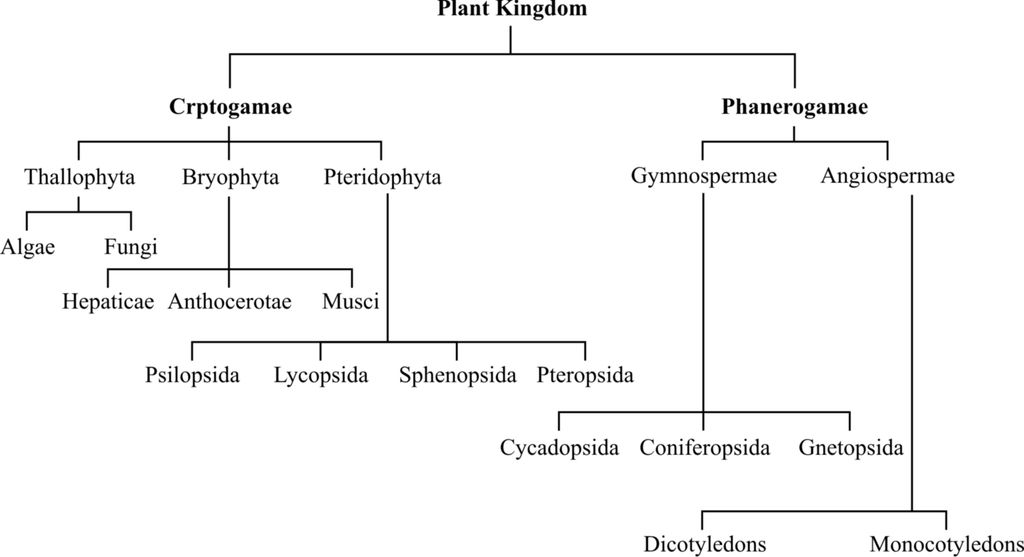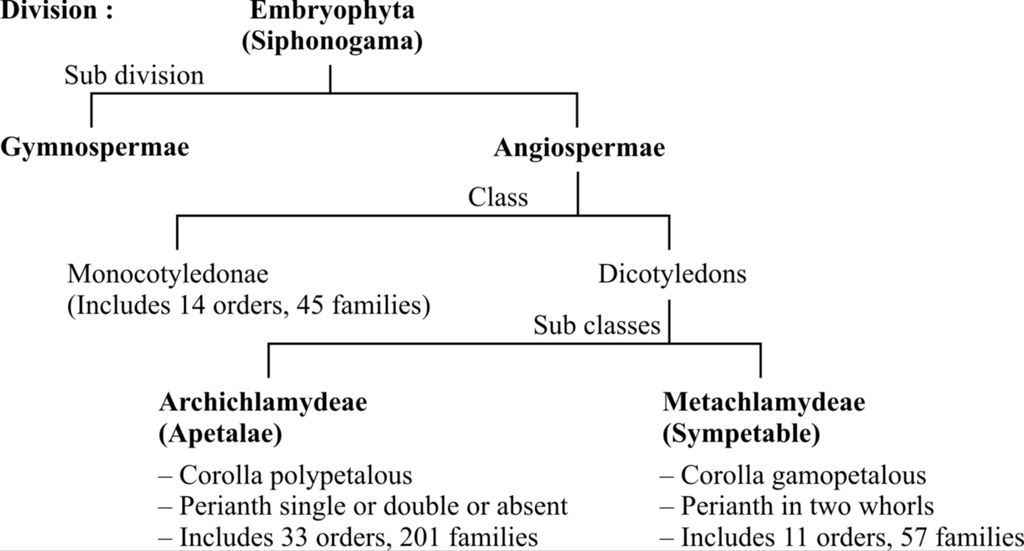- Books Name
- ACME SMART COACHING Biology Book
- Publication
- ACME SMART PUBLICATION
- Course
- CBSE Class 11
- Subject
- Biology
PLANT CLASSIFICATION SYSTEMS
Traditionally plant kingdom has been divided into two sub-kingdoms named as phanerogamae and cryptogamae.
(a) Cryptogamae (kryptos-concealed, gamos-marriage) :
All non flowering plants such as algae, fungi, lichen, mosses and ferns are included in this sub-kingdom.
The cryptogams are further classified into three divisions-thallophyta, bryophyta and pteridophyta.
(b) Phanerogamae (phaneros-visible, gamos-marriage) :
All flowering plants which bear seeds are included in this group. They are also known as spermatophytes (sperma-seed, phyton-plant), since they produce seeds.
These seed bearing plants are further divided into two divisions gymnospermae and angiospermae.
Gymnosperms have naked ovules or seeds. The angiosperms (covered seed) include all the flowering plants which produce seed and have ovules enclosed in ovary or fruit.

A. EARLY ATTEMPTS FOR CLASSIFICATION
Aristotle and other Greek philosophers divided living organisms into two groups: plants and animals. Aristotle also divided plants into 3 groups-herbs, shrubs and trees.
Charaka (the father of Ayurveda), in 1 st century A.D., listed 200 kinds of animals and 340 kinds of plants in his book 'Charaka Samhita'.
It is based on a few morphological characters of vegetative nature for grouping of organisms, e.g., early systems of classifications by Aristotle, Theophrastus, Pliny, Bauhin, Linnaeus etc.
Theophrastus proposed the first system of artificial classification of plants on the basis of habit and classified plants into herbs, shrubs, undershrubs and trees.
Carolus Linnaeus (1707-1778) proposed the artificial system of classification based exclusively on nature and number of stamens and carpels. It was called as Sexual System of Classification.
Classification by Linnaeus consisted of 24 classes, in which 23 classes were of flowering plants (Phanerogamia) and 24th class had flowerless plants (Cryptogamia). Details of this classification were published in Genera Plantarum (1737).
Total 24 classes given by Linnaeus were: Monandria, Diandria, Triandria, Tetrandria, Pentandria, Hexandria, Heptandria, Octandria, Enneandria, Decandria, Dodecandria, Icosandria, Polyandria, Didynamia, Tetradynamia, Monadelphia, Diadelphia, Polyadelphia, Syngenesia, Gynandria, Monoecia, Dioecia, Polygamia and Cryptogamia.
Drawbacks:
(i) This system was based on one or a few characters, hence the diverse animals or plants were placed into limited number of groups.
(ii) Natural affinities and phylogenetic relationships were not considered.
(iii) The artificial system gave equal weightage to vegetative and sexual characters; this is not acceptable and since we know that often the vegetative characters are more easily affected by environment.
C. Natural System of Classification
Also known as horizontal system of classification or 2 D system. Organisms in this system are classified on the basis of natural affinities. This system uses as many taxonomic characters as possible to group organisms.
This classification is mainly based on forms, relationship realising all information available at the time of collection of plants. This also considers internal features like ultrastructure, anatomy, embryology and phytochemistry .
Common natural systems were proposed by -John Ray, de Jussiaeu, de Candolle, Bentham and Hooker etc.
George Bentham and J.D. Hooker gave most important natural system of classification of angiosperms and published it in three volumes of 'Genera Plantarum'. They described 202 families. In this system, description of plants was based on their detailed studies and dissections. This system is followed in all British Common wealth countries including India
D. Phylogenetic System of Classification
The term phylogeny was given by Lamarck and concept of phylogeny by E. Haeckel. Phylogeny is the evolutionary history of the organism. This system is also called '3D' or vertical system.
In this system, plants are classified according to their evolutionary and genetic affinities. Organisms belonging to same taxa are believed to have a common ancestor and may be represented in the form of family tree called Cladogram.
A.W. Eichler modified Bentham and Hooker's system of classification by placing gymnosperms in the beginning. He is also called as the pioneer in phylogenetic system of classification.
Adolph Engler and Karl A.E. Prantl, two german botanists, adopted their system in "Die naturalichen Pflanzen famhien" (1887-1915). It was a German work which was later translated in English. The work had 23 volumes.
An outline of Engler and Prantl's System of Classification

Merits: In this system families are arranged according to increasing complexity of flowers.
Demerits: Monocots were considered primitive to dicots.
According to this system, primitive forms having naked flowers were kept in the beginning. The more advanced families have distinct perianth while the highly evolved families have fused perianth.
Hutchinson, Oswald Tippo, Takhtajan and Cronquist also proposed phylogenetic systems of classification.
John Hutchinson, an English botanist, proposed phylogenetic classification in his famous book 'Famillies of Flowering plants' in 1959.
In Hutchinson's classification:
(i) Trees and shrubs are considered to be more primitive than herbs
(ii) Dicots have been considered more primitive than monocots.
(iii) Polypetalous, actinomorphic and solitary flowers are considered more primitive than gamopetalous, zygomorphic and inflorescence respectively.
An outline of Hutchinson's System of Classification

The divisions include orders that include families. Division does not include classes.
Takhtajan classified Magnoliophyta (Angiospermae) into two classes-Magnoliopsida (dicotyledons) and Liliopsida (Monocotyledons).
BRANCHES OF TAXONOMY
1. Classical Taxonomy:
In this taxonomy, organisms are classified on the basis of natural affinities. These affinities or relationships realise all informations available at the time of collection of plant, e.g., natural systems of classification.
2. Numerical Taxonomy/Phenetics/Taximetrics/Adansonian Taxonomy:
In this taxonomy, there is use of numerical methods for the evaluation of similarities and differences between the species. Firstly, number and codes are assigned to all the characters.
Then, all possible characters are compared by sophisticated calculating machines and computers without giving emphasis on a particular character.
All characters considered for analysis are given equal importance. The organization and analysis of data forms the core of this taxonomy.
The family tree prepared on the basis of phenetics is called dendrogram.
3. Cytotaxonomy/Karyotaxonom
It is based on cytological informations of the cell, chromosome number, structure and behaviour of chromosomes during meiosis
4. Biochemical (Chemotaxonomy) :
It is related with the chemical properties of plant, for example, fragrance by the presence of any aromatic compound, presence of specific crystal structures of calcium oxalate (raphides) or calcium carbonate (cystolith).
The sequencing of DNA and chemical nature of proteins have also been used in this taxonomy.
Taxonomy is divided into three types by Turril.
1. α (Alpha) Taxonomy: It deals with the collection and identification of organism on the basis of gross morphology.
2. β (Beta) Taxonomy : It deals with the collection and identification of organism on the basis of morphology and all possible evidences from cytology, anatomy, physiology and genetics.
3. ω (Omega) Taxonomy : It is based on microscopic observations and biochemical evidences

 Maria Habib
Maria Habib
